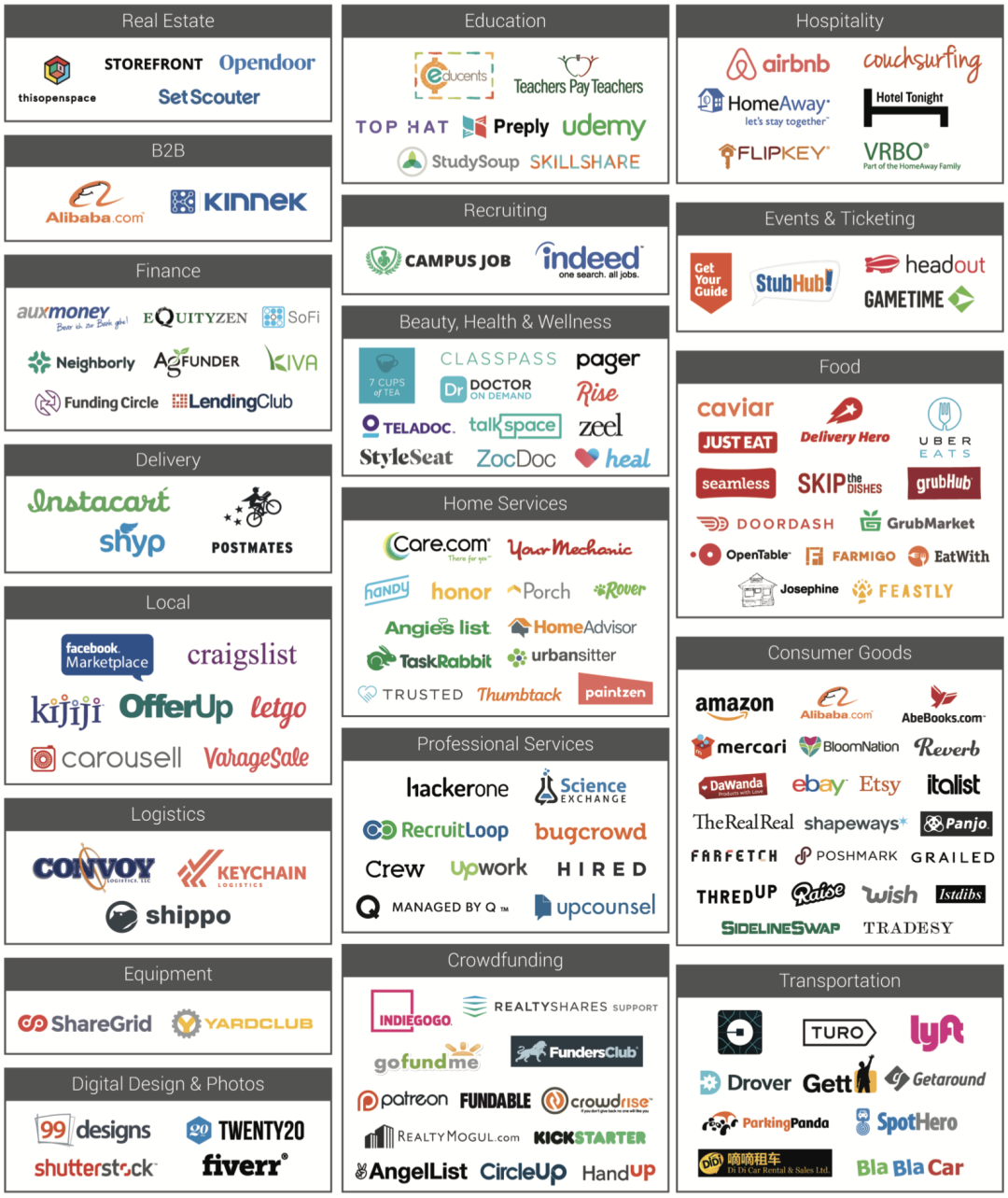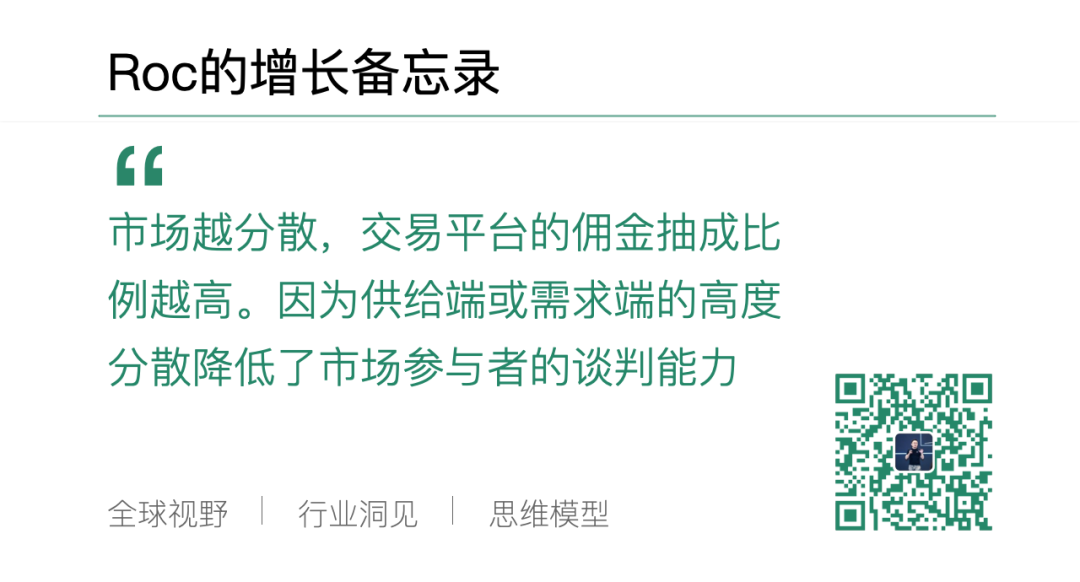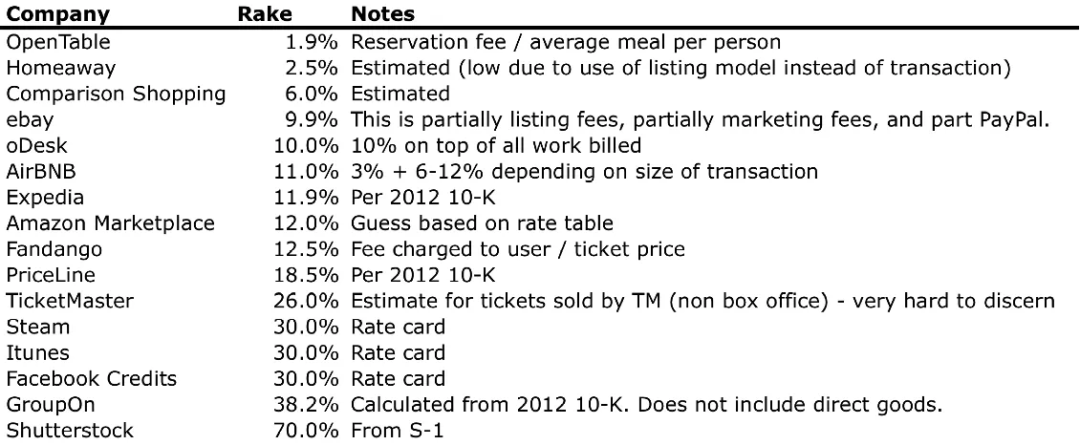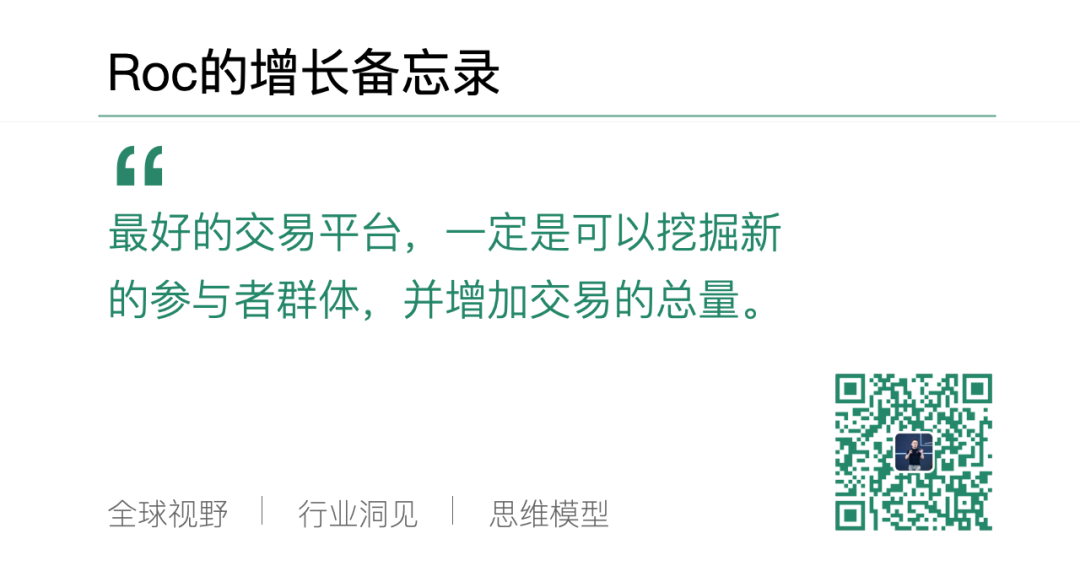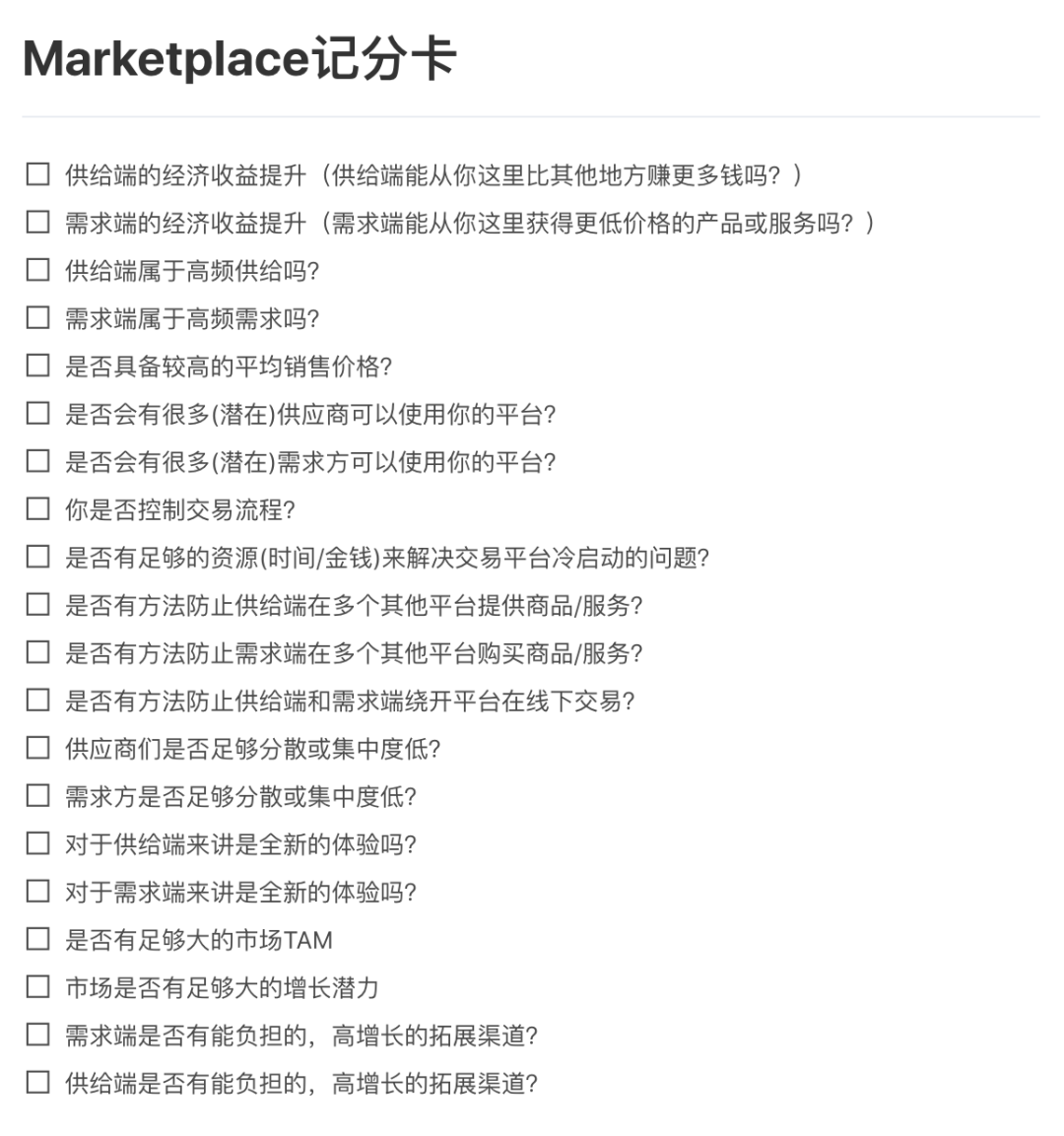The more decentralized the entire market, the higher the commission level of the trading platform.
Editor’s note: This article comes from the WeChat public account “Roc Growth Memo” (ID: RocGrowthMemo) , author : RocYu.
Starting a new season theme today, we will focus our growth on the “Marketplace trading platform” model. There are two reasons for adding it to the growth memo and becoming the theme of the new season:
-
Transactions as a basic activity of economics, from wholesale B2B commodities to peer-to-peer retail and service transactions, even if there have been many excellent companies emerging in the past, I still think there will be a large number of future Opportunities for segmentation and vertical trading markets exist;
-
Marketplace is a model, it is also a kind of bottom-level thinking, because all the behaviors of supply and demand and exchange can be regarded as transactions, and the supply and demand relationship is what needs to be understood behind any type of transaction behavior Underlying relationship, this mode of thinking has a wide range of versatility;
Although we were in the theme network effect of the last season, Building growth nuclear weapons ③: Airbnb ’s bilateral market network effect road has also mentioned airbnb ’s bilateral market, but I hope that through this season ’s theme, we can help you systematically understand and sort supply (supply) , Demand (demand), platform (Marketplace) the relationship between the three, based on this better understanding, architecture and implementation of this type of trading platform at product cold start, supply and demand growth rhythm, various stages of platform commercialization Strategy.
The first article in the second season will help us thoroughly understand what the Marketplace is, and the key indicators, and what are its core elements.
“Quick overview of articlesKEY TAKEAWAYS
-
There is a core reason why the online market can be established: it is difficult for buyers and sellers to find each other before, so the market has created efficiency in an otherwise inefficient market.
-
The more fragmented the entire market, the higher the commission level of the trading platform. This is because the high degree of decentralization on the supply side or the demand side reduces the negotiating ability of market participants;
-
Amazon founder Bezos likes to say very much: “Your profit is my opportunity”;
-
Uber ’s investor Bill Gurley said: “You must distinguish between the commission you can earn and the commission you should earn”;
-
After observing many high-quality trading platforms, I found a feature: they can expand the current market size based on the new value created
-
More sellers = higher platform participation = stronger platform liquidity = more transactions = higher overall platform value
01 What is a trading platform
What we mean by Marketplace is an online market / trading platform. Its essence is connection and matching. It connects people who want to provide products or services (sellers / suppliers) with people who want to buy products or services (buyers / buyer), and match and match.
Its advantages and disadvantages are obvious
Advantages:
-
Very low capital occupancy rate, the supplier provides the goods directly;
-
The market can self-correct and evolve based on changes in the supply of goods and demand
Disadvantages:
-
On the day of launch, a certain amount of goods / service providers are required on the platform, and it is difficult to cold start all platforms;
-
It is very difficult to control the quality of goods or services on the platform
There is a core reason why the online market can be established:
It ’s difficult for buyers and sellers to find each other before, so the market creates efficiency in an otherwise inefficient market.
The launch of eBay in 1995 triggered the first wave ofThe product-centric online market, Uber’s success in 2010 brought the second wave of online markets centered on services, or the combination of products and services (such as takeout). Today, we are approaching the third wave of information market driven by blockchain technology, online publishing, knowledge payment, etc.
Someone once asked me, does a free information aggregation platform or community belong to the online trading market? It depends on how we define transactions. If we regard time and attention as currency, such platforms will undoubtedly belong.
The transaction market is not necessarily a transaction of money and things, but also a transaction of things, attention and information, and information and information.
So as long as there is demand and supply, the exchanged things are what the other party needs. Generally speaking, they can be defined as transaction attributes.
Although these trading platforms are distributed in different market segments, each online market has two common elements.
1. Online market aggregation and large number of sellers with their goods / services inventory
What differentiates the online marketplace from the standard e-commerce site, E-commerce, is that goods and services are provided by third parties. In most cases, the online marketplace plays the role of digital intermediary.
When it comes to the online market with services as the core, supplier suppliers are often in a gray area (independent and flexible, not subject to the supervision and protection of labor laws); Markets, such as the initial platforms such as Didi, flash delivery, and dinner at home, but in the future, for quality control and customer experience, the platform has gradually turned these independent suppliers in gray areas into full-time employees, especially recently. The teaching quality K12 online education platform has begun to transform part-time teachers into full-time teachers in large quantities.
2. The online market must contain trading elements
Unlike craiglist, which is the same as the original information classification website 58, craiglist is that in the transaction process between buyers and sellers, the online market must handle part or all of the transactions between buyers and sellers.
There are even some online markets that cooperate with banks or capital to introduce and establish lower-cost capital pools, directly buy out supply-side inventory / (high-quality inventory), and then concentrate on advertising at the sales end for drainage, drainage, nutrition and conversion ,mentionIncrease the efficiency of the sales side. In some categories, this way of cutting a transaction into two transactions, first to solve the supply-side circulation, and then to solve the demand-side circulation, instead of matching efficiency is higher, the cost of selling a single inventory is lower. For example, the United States real estate trading platform Opendoor, the platform will directly buy the buyer’s real estate in cash, and the domestic Guazi used cars will directly buy the seller’s high-quality vehicles.
02 Two core indicators of the trading platform
Everyone should have heard of these two indicators. Let ’s quickly review them because they are indicators that any trading platform startup company will pay attention to. We will also discuss and dismantle in detail in the following articles based on these two indicators. Solve related sub-indicators of other indicators in Marketplace.
1.GMV (Gross Merchandise Value) total transaction amount:
GMV is the total value of all goods / services sold through the market within a given time. The net value of goods is the value of GMV minus returns (products) or cancellations (services). For markets where transactions are initiated on the platform but completed offline, accurate calculation of GMV can be tricky.
2. Take Rate / Rake commission ratio:
Take rate is also called Rake (from the word “pumping” in casino poker games), which refers to the percentage of transaction value charged by the market for transaction fees. Setting fee rates is usually the cornerstone of the monetization and business model of trading platforms.
-
The greater the value provided by a market, the more fees or percentages it charges. For example, if a market enables suppliers to find ten times more buyers than before, then suppliers are more likely to tolerate higher fees
-
When transactions are completed offline, it is difficult for the market to track these transactions and monetize based on the transaction rate
-
The more fragmented the entire market, the higher the commission level of the trading platform. This is because the high degree of decentralization on the supply side or the demand side reduces the negotiating ability of market participants;
Take rate design is directly related to the pricing strategy. This is a very complicated task. It will be combined with key factors such as strategy, cost, and competitive environment. :
1. Amazon founder Bezos likes to say very much: “Your profit is my opportunity”;
2. Uber investor Bill Gurley said: “You must distinguish between the commission you can earn and the commission you should earn”;
03 The six core elements of the trading platform
In Uber ’s early investor Bill Gurley ’s early 2012 blog post “All markets are not created equal: 10 factors to consider when evaluating digital marketplace”, and in the nfx Marketplace trading platform scorecard, the evaluation has been detailed The core factors of the trading platform are listed one by one.
I tried to summarize it into the six most important core elements:
1. High fragmentation highly fragmented / fragmented
If there are many existing or potential suppliers and buyers in a certain industry, it is much easier to create a trading platform. When there are only a few suppliers, they may resist such a new intermediary in the market, the core is that they are not willing to share benefits (this also means that you may only be able to extract a very small amount of commission from the transaction ). In addition, trading platforms can create the most value in a highly fragmented market, because buyers and sellers do need to find each other quickly.
2. The buyer / seller relationship
In the trading market where certain buyers will continue to use a supplier once they are determined, the continuous value of the trading platform will gradually be lost, such as finding a barber they like or trust through the platform , Doctors, or masseurs on-site massage, or wholesale purchases of goods, buyers will be more willing to insist on transactions with familiar suppliers, rather than risk, to spend time to find new suppliers, at this time, The dependence of the platform will be reduced.
3. Higher frequency trading with higher frequency
Bill Gurley said, “The market is inherently unfair, and a platform where high-frequency trading occurs is obviously better than low-frequency.” Meituan reviews, Didi, and shared bicycles are all typical cases of high-frequency use. At this time, consumers will very clearly regard them as a tool to respond to a specific problem. There are many failed trading platforms, and the purchase cycle is not frequent, which makes the process of building familiarity, trust, word of mouth and brand more difficult.
But here is a reminder that we must learn to distinguish between the frequency of use and the frequency of purchase. For example, we need an aunt to help with housework every day, but it may take a year or two to find a new nanny.
4.Total Available Market (TAM) market volume
For the beginning of any new trading platform, a reasonable assessment of TAM is necessary: how big is this market plate, what is the increment, and how much can I serve.
After observing many high-quality trading platforms, I found a feature: they can expand the current market size based on the new value created. It is difficult to accurately describe the greater future opportunities in the current market size of.
When Didi, Uber entered the traditional car rental market as a new dark horse, they did not completely squeeze the original market share, but more through this convenient and more friendly experience. Many people started to use it to expand the share of the entire travel market.
5.Transactional: being part of payment becomes a part of the transaction
When buyers and sellers need to trade in the market, the potential commission collection capacity will be much higher than when offline transactions. When the trading platform processes the transaction, it pays the supplier a portion of the revenue and also automatically deducts the commission fee without having to send the supplier a bill in the future. This method of charging after facilitating a transaction is also more acceptable to most sellers.
6. The ability to expand the overall market and create value
In fact, all markets can create efficiency. They make it easier for buyers and sellers to find each other and complete transactions. However, not all trading platforms can create value equally, or create more new value.
For example, the trading platform can connect schools to teachers, hospitals to doctors, and shopping malls to retailers interested in opening “flash shops.” Of course, these can improve efficiency, but they may not necessarily expand the market.
Possible reasons are limited supply andLimited demand. In other words, a new market will not create a new batch of teachers or doctors, or schools and hospitals. In the absence of a new online market, both parties will eventually find each other, albeit in a relatively inefficient way.
The best trading platform must be able to tap new groups of participants and increase the total amount of transactions
The sharing economy, which was all the rage in the past, is a good example of creating new value. Those who never thought they would become landlords or hotel owners are now Airbnb hosts. Moreover, those who never thought they would provide a ride service for money are now Didi drivers. These platforms make brand-new groups become the supply side.
More sellers = higher platform participation = more liquidity = more transactions = higher overall platform value
To build a good market, you do n’t need to meet all six criteria (or ten criteria on the Bill list). But the higher your score, the higher the overall market potential. Attach the most complete trading platform scorecard and try to rate your own trading platform.
Thinking questions: In the early days of the trading platform, taking the knowledge-paying / online publishing platform as an example, what way can mass mobilization of high-quality course producers join the platform?
Trailer: In the follow-up article, I will work with you to learn the strategy of the three core stages of the trading platform from initialization / cold start, to early growth, to scale expansion; then it is to find suitable business Models, measuring various data indicators of trading platforms, and the evolution of new types of trading platforms and service-based trading platforms.
-
-
-
-
-
